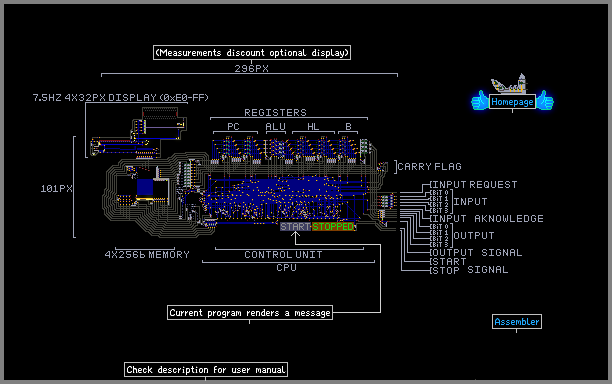Tesla-A8D4 Computer by Sam_Hayzen

User manual: https://powdertoy.co.uk/Discussions/Thread/View.html?Thread=22409
computer
programmable
display
render
message
small
memory
Comments
-
QuanTech 9th Jan 2018
 very nice +1
very nice +1 -
Cool4Cool 9th Jan 2018
 When I run the simulation at ~135 fps, the display looks better :-)
When I run the simulation at ~135 fps, the display looks better :-) -
Sam_Hayzen 9th Jan 2018
 Ah, I see what you mean. But that would require connecting the GPU to the Control Unit on the disk to redirect writes to the GPU if the address is 0xE0 or greater, and that would likely mean making 0xE0 to 0xFF unreadable.
Ah, I see what you mean. But that would require connecting the GPU to the Control Unit on the disk to redirect writes to the GPU if the address is 0xE0 or greater, and that would likely mean making 0xE0 to 0xFF unreadable. -
Cool4Cool 9th Jan 2018
 LBPHacker embodied this concept in ID:2007083 for his addressers (the bottom one). Right now, your display scans every position, so it takes a long time to print each character. If instead the PSTN jumped to exactly where you wanted to output, it wouldn't need to take 4 seconds to scan in each character. Implement the concept if you want, still a great CPU build nevertheless.
LBPHacker embodied this concept in ID:2007083 for his addressers (the bottom one). Right now, your display scans every position, so it takes a long time to print each character. If instead the PSTN jumped to exactly where you wanted to output, it wouldn't need to take 4 seconds to scan in each character. Implement the concept if you want, still a great CPU build nevertheless. -
Sam_Hayzen 9th Jan 2018
 I already know of that method and It's in use in the Control Unit for the CPU. But, how would that make the display faster if it already takes eight frames to process each byte?
I already know of that method and It's in use in the Control Unit for the CPU. But, how would that make the display faster if it already takes eight frames to process each byte? -
Cool4Cool 8th Jan 2018
 That's okay! If you set PSTN to powers of 2, or something like that, and line them up, sparking the different PSTNs according to a binary pattern (101 means sparking pstn 1 and 3) will make the PSTN extend to the exact position you want. This doesn't have to be subframe, and it makes the display way faster.
That's okay! If you set PSTN to powers of 2, or something like that, and line them up, sparking the different PSTNs according to a binary pattern (101 means sparking pstn 1 and 3) will make the PSTN extend to the exact position you want. This doesn't have to be subframe, and it makes the display way faster. -
Sam_Hayzen 8th Jan 2018
 Thanks for the advice, but I'm still trying to wrap my head around Subframe \_('-')_/
Thanks for the advice, but I'm still trying to wrap my head around Subframe \_('-')_/ -
Cool4Cool 8th Jan 2018
 +1, great computer. Always got to admire the time and dedication put into turning a complicated jumble of ARAY guns into a working CPU. For the display, I would suggest you either subframe it or find a way to make the PSTN "jump" to any position, not just moving in a scanning order. Nice work!
+1, great computer. Always got to admire the time and dedication put into turning a complicated jumble of ARAY guns into a working CPU. For the display, I would suggest you either subframe it or find a way to make the PSTN "jump" to any position, not just moving in a scanning order. Nice work!